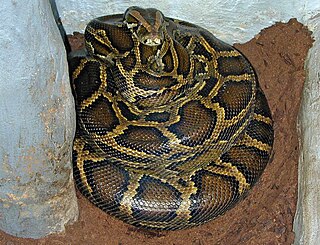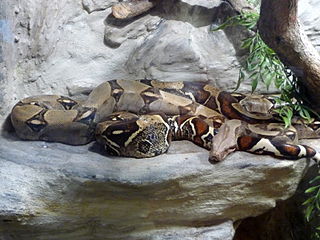Related Research Articles

The Pythonidae, commonly known as pythons, are a family of nonvenomous snakes found in Africa, Asia, and Australia. Among its members are some of the largest snakes in the world. Ten genera and 39 species are currently recognized. Being naturally non-venomous, pythons must constrict their prey to suffocate it prior to consumption. Pythons will typically strike at and bite their prey of choice to gain hold of it; they then must use physical strength to constrict their prey, by coiling their muscular bodies around the animal, effectively suffocating it before swallowing whole. This is in stark contrast to venomous snakes such as the rattlesnake, for example, which delivers a swift, venomous bite but releases, waiting as the prey succumbs to envenomation before being consumed. Collectively, the pythons are well-documented and -studied as constrictors, much like other non-venomous snakes, including the boas and even kingsnakes of the New World.

The reticulated python is a python species native to South and Southeast Asia. It is the world's longest snake, and the third heaviest after the green anaconda and Burmese python. It is listed as least concern on the IUCN Red List because of its wide distribution. In several countries in its range, it is hunted for its skin, for use in traditional medicine, and for sale as pets. Due to this, reticulated pythons are one of the most economically important reptiles worldwide.

Everglades National Park is an American national park that protects the southern twenty percent of the original Everglades in Florida. The park is the largest tropical wilderness in the United States and the largest wilderness of any kind east of the Mississippi River. An average of one million people visit the park each year. Everglades is the third-largest national park in the contiguous United States after Death Valley and Yellowstone. UNESCO declared the Everglades & Dry Tortugas Biosphere Reserve in 1976 and listed the park as a World Heritage Site in 1979, and the Ramsar Convention included the park on its list of Wetlands of International Importance in 1987. Everglades is one of only three locations in the world to appear on all three lists.

The Burmese python is one of the largest species of snakes. It is native to a large area of Southeast Asia and is listed as Vulnerable on the IUCN Red List. Until 2009, it was considered a subspecies of the Indian python, but is now recognized as a distinct species. It is an invasive species in Florida as a result of the pet trade.

The Indian python is a large python species native to tropical and subtropical regions of the Indian subcontinent and Southeast Asia. It is also known by the common names black-tailed python, Indian rock python, and Asian rock python. Although smaller than its close relative the Burmese python, it is still among the largest snakes in the world. It is generally lighter colored than the Burmese python and reaches usually 3 m. Like all pythons, it is nonvenomous.

Python is a genus of constricting snakes in the Pythonidae family native to the tropics and subtropics of the Eastern Hemisphere.

The Central African rock python is a species of large constrictor snake in the family Pythonidae. The species is native to sub-Saharan Africa. It is one of 10 living species in the genus Python.
The Crocodile Lake National Wildlife Refuge is part of the United States National Wildlife Refuge System, located in north Key Largo, less than 40 miles (64 km) south of Miami off SR 905. The 6,686 acre (27.1 km2) refuge opened during the year of 1980, under the Land and Water Conservation Fund Act of 1965 and the Endangered Species Act of 1973. It was established in order to protect critical breeding and nesting habitat for the threatened American crocodile and other wildlife. This area also includes 650 acres (2.6 km2) of open water in and around the refuge. In addition to being one of only three breeding populations of the American crocodile, the refuge is home to tropical hardwood hammock, mangrove forest, and salt marsh. It is administered as part of the National Key Deer Refuge which is also located in the Florida Keys.

The Central Florida Zoo and Botanical Gardens is a 116-acre (47 ha) zoo and botanical garden located north of Orlando, Florida in Sanford. As a not-for-profit organization, it is a leader in conservation, providing experiences that inspire actions on behalf of wildlife. The Zoo has been an accredited member of the Association of Zoos and Aquariums (AZA) since 1986.
There are a number of environmental issues in Florida. A large portion of Florida is a biologically diverse ecosystem, with large wetlands in the Everglades. Management of environmental issues related to the everglades and the larger coastal waters and wetlands have been important to the history of Florida and the development of multiple parts of the economy of Florida, including the influential agricultural industry. This biodiversity leaves much of Florida's ecological ecosystem vulnerable to invasive species and human sources of industrial pollution and waste.

Burmese pythons are native to Southeast Asia. However, since the end of the 20th century, they have become an established breeding population in South Florida. The earliest python sightings in Florida date back to the 1930s and although Burmese pythons were first sighted in Everglades National Park in the 1990s, they were not officially recognized as a reproducing population until 2000. Since then, the number of python sightings has exponentially increased with over 30,000 sightings from 2008 to 2010.

The Ten Thousand Islands National Wildlife Refuge is located in Southwest Florida in Collier County, between Marco Island and Everglades City, Florida. The refuge was first established in 1996 and covers 35,000 acres of the Ten Thousand Islands. The refuge includes both fresh and saltwater, and protects a large area of mangrove forest.

Mega Python vs. Gatoroid is a 2011 monster, science-fiction, disaster film by The Asylum, directed by Mary Lambert, and starring pop singers Debbie Gibson and Tiffany. The film premiered theatrically in Texas and premiered on television on January 29, 2011, on Syfy in the United States before being released on home video on June 21, 2011.

The boa constrictor, also known as the common boa, is a species of large, non-venomous, heavy-bodied snake that is frequently kept and bred in captivity. The boa constrictor is a member of the family Boidae. The species is native to tropical South America. A staple of private collections and public displays, its color pattern is highly variable yet distinctive. Four subspecies are recognized. This article focuses on the species Boa constrictor as a whole, and on the nominate subspecies B. c. constrictor.
The dwarf Burmese python is an insular dwarf subspecies of the Burmese python. The dwarf Burmese python is native to the Indonesian islands of Java, Bali, Sumbawa, and Sulawesi. The dwarf subspecies seems to have a maximum length of 8.2 ft (2.5 m). In 2009, the dwarf Burmese python was officially recognized as a subspecies of the Burmese python.

Florida hosts many types of fauna. From coral reefs of the Florida Keys to the cypress swamps of the Panhandle, the state's diverse habitats are home to a variety of wildlife. Florida is among the top five states in terms of endemic species. There are over 700 terrestrial animals, 200 freshwater fish species, 1,000 marine fish and thousands of terrestrial insects and other invertebrates that inhabit the state. Florida's peninsular geography spans from subtropical to tropical zones, which, combined with its distinctive geology and climate, contribute to habitat diversity and an array of species. The native wildlife that exists in the state are of temperate and tropical origin.
References
- 1 2 [ dead link ]
- 1 2 [ dead link ]
- 1 2 "SIB 318 & SB 572". Myfloridahouse.gov. Retrieved 2015-02-26.
- ↑ "Nonnative Permit". Myfwc.com. Retrieved 2015-02-26.
- ↑ "Reptiles of Concern". Archived from the original on November 5, 2011. Retrieved December 1, 2011.
- 1 2 "Burmeses Pythons in South Florida : Scientific Support for Invasive Species Management" (PDF). Edis.ifas.ufl.edu. Archived from the original (PDF) on 2009-11-17. Retrieved 2015-02-26.
- 1 2 "USGS Release: USGS Maps Show Potential Non-Native Python Habitat Along Three U.S. Coasts (2/20/2008 10:45:00 AM)". Usgs.gov. Retrieved 2015-02-26.
- 1 2 "USGS Release: USGS Maps Show Potential Non-Native Python Habitat Along Three U.S. Coasts (2/20/2008 10:45:00 AM)". Usgs.gov. Retrieved 2015-02-26.
- ↑ "What Parts of the U.S. Mainland Are Climatically Suitable for Invasive Alien Pythons Spreading from Everglades National Park?" (PDF). pp. 1–18. Archived from the original (PDF) on August 14, 2011. Retrieved March 17, 2023.
- 1 2 3 Pyron, R. A.; Burbrink, F. T.; Guiher, T. J. (2008). "Burmese Pythons Will Find Little Suitable Habitat Outside South Florida, Study Suggests". PLOS ONE. ScienceDaily. 3 (8): e2931. doi: 10.1371/journal.pone.0002931 . PMC 2490718 . PMID 18698351 . Retrieved 2015-02-26.
- 1 2 "Invasion of the Giant Pythons ~ Herpetologist Shawn Heflick Answers Your Questions | Nature". PBS. 2010-02-19. Retrieved 2015-02-26.
- ↑ "Invasion Of Gigantic Burmese Pythons In South Florida Appears To Be Rapidly Expanding". ScienceDaily. Retrieved 2015-02-26.
- ↑ "06 » 'Judas Snakes' help researchers remove pythons from the Everglades » University of Florida". News.ufl.edu. Archived from the original on 2013-10-29. Retrieved 2015-02-26.